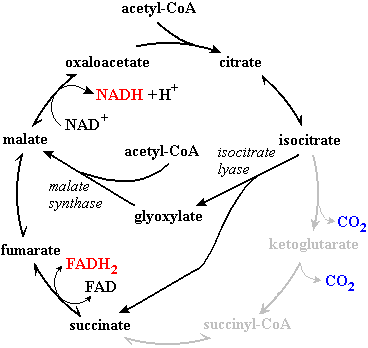
Glyoxylate cycle-steps
- Glyoxylate cycle occurs in some microorganisms when acetate is sole source of carbon
- This cycle has two unique enzyme- isocitrate lyase and malate synthase which bypass some of the reaction of TCA cycle.

figure: Glyoxylate cycle
- Glyoxylate cycle is absent in higher organism.
- At first acetylcoA is produced from acetate or by oxidation of higher fattyacids.
- AcetylcoA then enter into TCA cycle and condensed with oxaloacetate to form citrate.
- Citrate then isomerized to isocitrate.
- Isocitrate lyase bypass the TCA cycle by splitting isocitrate into succinate and glycoxylate.
- Succinate metabolized by TCA whereas Glycoxylate condenses with another molecule of acetylcoA to form malate in the presence of malate synthase.
- Malate is converted into oxaloacetate by the enzyme malate dehydrogenase.
Significance of Glyoxylate cycle
- It is bypass reaction of TCA cycle
- It occurs in bacteria when they are cultured in acetate rich carbon source.
- When Higher fattyacids are oxidized into acetylcoA without forming puruvate acids, then acetylcoA enters into glyoxylate cycle.
